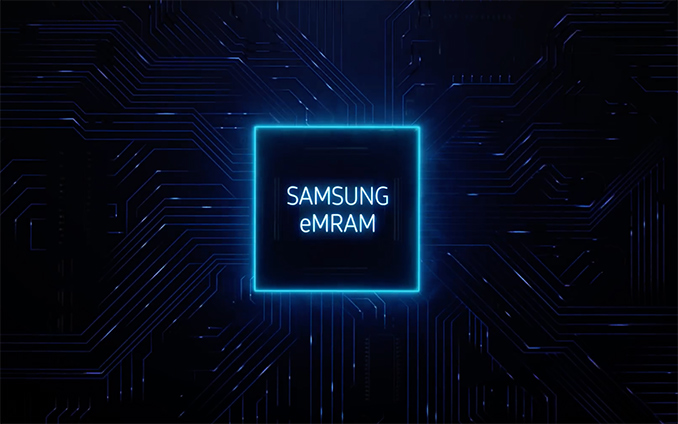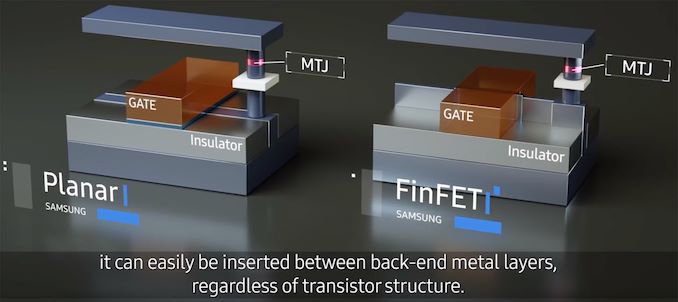Samsung Ships First Commercial Embedded MRAM (eMRAM) Product
by Anton Shilov on March 6, 2019 4:00 PM EST
Samsung today announced that it has started mass production of its first commercial embedded Magnetic Random Access Memory (eMRAM). Made using its 28FDS (28nm FD-SOI) process technology, the eMRAM module promises to offer higher performance and endurance when compared to eFlash. Furthermore it can be integrated into existing chips, according to the manufacturer.
Magneto resistive RAM uses a resistance-based method that determines what data is stored in a cell, which in turn is based on reading the orientation of two ferromagnetic films separated by a thin barrier. Samsung calls this process Magnetic Tunnel Junction, or MTJ.
MRAM is one of the highest-performing and most durable non-volatile memory technologies currently exists. Because its eMRAM does not require an erase cycle before writing data, it is 1,000 times faster than eFlash, Samsung says. It also uses lower voltages when compared to eFlash, and therefore consumes around 1/400th the energy during writing process, according to the maker.
On the flip side, however, MRAM’s density and capacity both fall far short of 3D XPoint, DRAM, and NAND flash, which greatly reduces its addressable markets. Samsung is not formally disclosing the capacity of its new eMRAM module; the company is only saying that it yet has to tape out a 1 Gb eMRAM chip in 2019, which strongly suggests that the current offering has a lower capacity.
Made using Samsung’s 28FDS process technology, Samsung's eMRAM module can be integrated in the back-end of a chip's manufacturing process by adding three additional masks. As a result, the module does not necessarily depend on what front-end manufacturing technology is used, allowing it to be inserted into chips produced using bulk, FinFET, or FD-SOI fabrication processes.
Given its limited capacity, Samsung says that the module is primarilly aimed for use in microcontrollers, chips for IoT, and AI (neural network, machine learning, etc.) applications.
Meanwhile, Samsung says that it will keep expanding its embedded non-volatile memory offerings going forward. Among the upcoming options is its 1 Gb eMRAM test chip, whose tape-out is scheduled for later this year. Farther down the line still, Samsung is also planning to make eMRAM using its 18FDS process, as well as more advanced FinFET-based nodes.
Related Reading:
- IBM And Everspin Announce 19TB NVMe SSD With MRAM Write Cache
- Seagate Demos New SSD Features And Prototypes At FMS
- Everspin Announces New MRAM Products And Partnerships
- MRAM Developer Day, GlobalFoundries Keynote Live Blog
Source: Samsung












25 Comments
View All Comments
saratoga4 - Thursday, March 7, 2019 - link
>If this is supposed to be some sort of replacement for NAND flash (including that awful QLC they're foisting on us as a solution to persistent storage to replace already awful TLC that replaced marginally acceptable MLC)It is not supposed to be a replacement for NAND flash, nor would it work as one.
> then they need to talk about P/E cycle endurance.
Not so relevant for these applications, but MRAM variants in general are usually millions to billions of write cycles. Effectively infinite.
>dead consumer electronics components that are no longer useful thanks to soldered on storage failing only a few years into its service life.
You don't solder in on-die memory ... it is on the same die as the processor. That is the whole point.
ads295 - Thursday, March 7, 2019 - link
Am I missing something here? Why is RAM being compared to non-volatile memory such as NAND?Also, whats eFlash? eMMC?
Xyler94 - Thursday, March 7, 2019 - link
This Samsung MRAM (or eMRAM) is non-volatile, which normal DRAM is.Fun fact, SRAM, which is typically used in CPU Cache is also non-volatile and is the quickest RAM out there... but also so incredibly expensive. RAM stands for Random Access Memory, so any storage tech that does Random Access can be considered RAM.
Comparing it to NAND Flash is acceptable, because like NAND, it's non-volatile. As for the other questions, someone smarter than me will have to answer that
Billy Tallis - Friday, March 8, 2019 - link
DRAM and SRAM are both volatile in that they lose their data when the chip loses power, though only DRAM requires periodic refreshing. SRAM requires a continuous power supply and the several transistors that make up each memory cell maintain the state.Flash memory and MRAM are non-volatile memories that keep their data even when all power is removed.
MFinn3333 - Thursday, March 7, 2019 - link
MRAM is as fast as DRAM but doesn't lose information if the power is cut.It's endurance is well beyond that of Flash. Like 10^10 power of writes or 10 Billion writes.
It can write data faster than any other type of storage. 14ns to write 128Mb.
It's going to be used in AI chips.